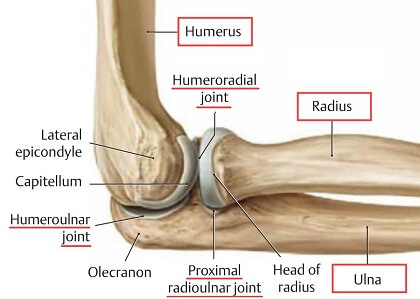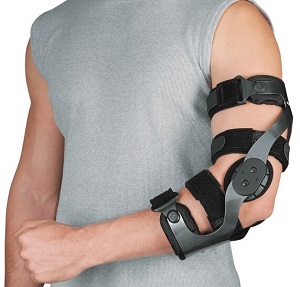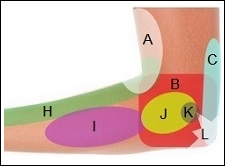- Home
- Elbow Pain Diagnosis
- Hyperextended Elbow
Hyperextended Elbow
Written By: Chloe Wilson BSc (Hons) Physiotherapy
Reviewed By: SPE Medical Review Board

A hyperextended elbow is when your elbow joint is bent back too far the wrong way.
It causes pain, inflammation, ligament damage and in severe cases elbow fracture or dislocation.
Elbow hyperextension usually happens when the elbow is suddenly forced backwards.
This is most common during sports such as gymnastics, weight lifting, martial arts or football, but can also happen with a fall onto an outstretched arm.
Most cases of a hyperextended elbow can be treated non-surgically with a combination of rest, medication, exercises, physical therapy and bracing. But if there are ongoing problems with elbow instability, then surgery may be advised.
Here we will look at the common causes, symptoms, diagnosis, treatment options and recovery process for a hyperextended elbow.
What Is A Hyperextended Elbow?
An elbow hyperextension injury is where the elbow joint bends back beyond its normal range of motion.
The elbow connects the upper arm to the forearm and is actually made up of three joints:

- Humeroulnar Joint: Between the upper arm and inner forearm bones
- Humeroradial Joint: Between the upper arm and outer forearm bones
- Proximal Radioulnar Joint: Between the two forearm bones
These joints work together to allow the elbow to flex and extend, i.e. bend and straighten, and the forearm to rotate, so you can turn your hand up and down.
Elbow hyperextension occurs at the humeroulnar joint. The humeroulnar joint, aka olecranon joint, is a synovial hinge joint. The elbow is supported by various ligaments and a joint capsule, a bag like structure that surrounds the joint and contains nourishing fluid.
With a hyperextension elbow injury, the structures at the front of the elbow are overstretched and the structures at the back of the elbow get compressed, which may result in:
- Ligament Sprain: over-stretching and possible tearing of one or more of the elbow ligaments
- Cartilage Tear: tearing in the cartilage that lines the joint
- Loose Body: a small fragment of bone or cartilage may break off
- Capsule Damage: the joint capsule may get overstretched or pinched resulting in synovitis (inflammation)
- Bone Damage: if the hyperextension force is high enough it can result in an elbow dislocation or fracture (a break in one of the bones)
The greater the hyperextension force through the elbow, the more damage there is likely to be.
What Causes Elbow Hyperextension?
In most cases, a hyperextended elbow is caused by a one-off injury from:

- Contact Sports: e.g. boxing, football, martial arts
- Vigorous Physical Activities: using the arms e.g. gymnastics and weightlifting
- A Fall: bracing yourself from a fall and landing on an outstretched arm
Elbow hyperextension injuries can also happen gradually over time from repetitive activities such as throwing sports e.g. baseball or cricket, and racket sports e.g. tennis, particularly with poor technique.
There are also some risk factors that can increase your susceptibility to elbow hyperextension:
- Aging: as we age, our bones become weaker and more brittle and our ligaments lose flexibility, making them more prone to damage
- Previous Injuries: previous arm or elbow injuries can result in weakness and stiffness in and around the joint making it more prone to future damage
- Hypermobility: some people have overly flexible joints that bend beyond the normal range of motion which can put the elbow at risk of injury
Hyperextended Elbow Symptoms
Common symptoms of elbow hyperextension injuries include:
- Popping Sound: at the time of injury
- Pain: sudden intense pain at the time of injury and ongoing pain as you straighten your arm – may be dull or sharp
- Tenderness: around the elbow to touch or pressure
- Stiffness: in the elbow may limit extension. If a loose body of bone or cartilage has broken off, it may get caught in the joint and block movement
- Weakness: loss of strength in the arm muscles
- Muscle Spasms: particularly in the biceps muscle as it tries to protect the elbow from further damage
- Swelling: in the elbow joint due to excess fluid and/or bleeding in the joint
Severe hyperextended elbow injuries involving bone damage or dislocation can lead to obvious deformity at the elbow, reduced circulation and nerve damage. This may lead to tingling, numbness and temperature changes in the forearm and hand.
Hyperextended Elbow Diagnosis
If you have suffered from a hyperextension elbow injury you should see your doctor as soon as possible. They will start by taking a history where they will ask you lots of questions about how the injury happened, your symptoms, medical history and normal activities.
They will then carry out a physical examination. They will start by looking at the shape and position of your arm to evaluate any deformity, swelling or bruising. They will then look at the movement and strength in your arm, including shoulder, elbow, forearm, wrist and hand movements.
You doctor may also send you for imaging scans such as x-rays, MRI or CT scans to check for bone and soft tissue damage. If a hyperextended elbow isn't sound quite like your pain, visit the elbow pain diagnosis section for help working out what's wrong.
Hyperextended Elbow Treatment
Hyperextended elbow treatment can normally be carried out at home and may include:
1. Rest
Resting from any aggravating activities initially following an elbow hyperextension injury allows the joint and soft tissues time to heal and reduces the risk of further injury.
You may need to wait anything from a few days to a few weeks before returning to sports. Don’t be tempted to rush back too quickly, it will only slow down your hyperextended elbow recovery time. It may take anything up to a few months to return to pre-injury levels depending on the extent of damage.
2. Ice
Applying ice as soon as possible after injury is a really important part of acute hyperextended elbow treatment. The ice helps to reduce the amount of swelling that builds up in the elbow joint and helps to relieve pain.
If possible, place an ice pack over the injured elbow for 10-15 minutes every couple of hours for the first few days following injury. Make sure to wrap the ice pack in something e.g. thin towel, so it is not directly on your skin as this helps to prevent the risk of ice burns.
3. Compression
Wearing a compression bandage such as tubigrip with a hyperextended elbow can help to both support the joint and reduce swelling. These help to speed up the recovery process and protect the joint from further injury.
Ideally tubigrip should be worn double thickness and should run from just below the shoulder down to the wrist in order to be most effective.
4. Elevation
When you are sitting or lying down, prop your arm up on some pillows so that gravity can help reduce any swelling. Ideally, you want your elbow to be higher than your heart, and make sure your hand is raised too otherwise the swelling from the elbow will pool into your hand. You want the excess fluid to drain towards your shoulder where it will be absorbed.
5. Medication
Over-the-counter pain relief and anti-inflammatory medications can help to reduce the pain and swelling associated with a hyperextended elbow e.g. paracetamol/acetaminophen (Tylenol) and ibuprofen (Advil).
If you are taking both, try and space them out through the day rather than taking them at the same time e.g. after taking one, wait a couple of hours before taking the other. This helps you to keep on top of the pain.
Always check with your doctor or pharmacist before starting any new medication and check dosages carefully.
6. Exercises
Strengthening and stretching exercises are an important part of hyperextended elbow treatment. You should be able to start some gentle exercises a few days after an elbow hyperextension injury.
Strengthening work usually starts with isometric exercises where the muscle is activated but doesn’t change length meaning there is very little risk of aggravating the injury. You should then soon be able to progress on to active exercises and stretches to help you regain full strength and range of motion in the elbow and forearm. Muscle tightness is a common problem with a hyperextended elbow and biceps stretches are a great place to start.
You may need to continue with strengthening and stretching exercises for around 3 – 6 months depending on the severity of your elbow hyperextension injury to make sure you regain full strength, stability, flexibility and mobility in your arm otherwise you will be at greater risk for further injuries in the future.
7. Physical Therapy
Your doctor may recommend a course of physical therapy as part of your hyperextended elbow treatment. Physical therapy treatment may involve a combination of rehab exercises, joint mobilisations, electrotherapy and taping.
8. Hyperextended Elbow Brace

If there is marked instability, hypermobility or bone damage after an elbow hyperextension injury then you may be advised to wear an elbow brace for a while.
There are different styles of elbow braces available – some provide gentle support to the elbow whereas other restrict range of motion to prevent you hyperextending the elbow again and risking further damage.
In most cases, you should only need to wear your hyperextended elbow brace for a few days. It is important not to wear it for longer than necessary otherwise you are likely to develop weakness and tightness in the arm muscles. You may however want to wear a brace when playing sports initially until you have regained full strength in the elbow.
9. Surgery
Severe cases of a hyperextended elbow involving bony injuries or significant soft tissue damage may require surgery. This is usually only the case when there is a fracture, torn ligaments or muscles or nerve damage, or if there are ongoing problems with elbow instability despite physical therapy.
If possible, elbow surgery will be carried out arthroscopically with keyhole surgery as the recovery time is much shorter but in complex cases, open surgery involving a large incision may be required.
Following surgery, the elbow may be immobilised in a cast/brace for a period of time while the elbow heals. When appropriate you will then be able to start on a rehab program with a physical therapist until the elbow is fully healed.
Hyperextended elbow recovery after surgery can take anywhere from a few weeks to a few months depending on the type of surgery and the extent of the damage.
Hyperextended Elbow Recovery & Prevention
In most cases, elbow hyperextension injuries settle down within a few weeks with a combination of PRICE (protect, rest, ice, compression & elevation) and exercises.
If the injury occurred during non-contact sports, it is important to make sure that your technique did not contribute to the injury. Work with a coach to check and if necessary improve your technique, e.g. racket angle in tennis or hand/arm position in gymnastics tumbling, particularly if the injury was caused by repetitive hyperextension rather than a one-off injury.
It is also important to ensure you have good strength, endurance and flexibility in and around the elbow. Biceps and triceps strengthening and stretching exercises and scapular stability exercises can help ensure this and reduce the risk of future elbow injuries.
If you have hypermobility syndrome, then wearing an elbow splint or brace when doing sports can help reduce the risk of repetitive hyperextension and prevent a hyperextended elbow injury.
Summary
- A hyperextended elbow is when the elbow is forced backwards and bend back further than it should
- This can lead to damage of the bones and soft tissues in and around the elbow
- Common causes of a hyperextended elbow include sports e.g. gymnastics, weightlifting and football or a fall onto an outstretched hand
- Hyperextended elbow symptoms may include a popping sound at the time of injury, pain, swelling, joint stiffness and weakness
- In most cases, elbow hyperextension injuries can be treated at home with a combination of PRICE and exercises
- More severe injuries may require surgery to fix broken bones or torn ligaments
- Hyperextended elbow recovery may take anything from a few days to a few months depending on the severity of the injury
- If this doesn't sound quite like your pain, visit the elbow pain diagnosis section for help working out what's wrong
Page Last Updated: 11/15/2022
Next Review Due: 11/15/2024


